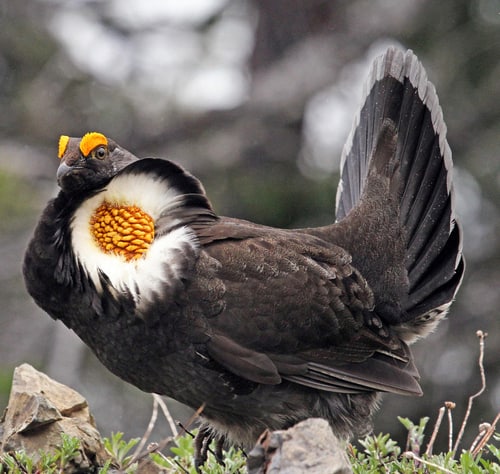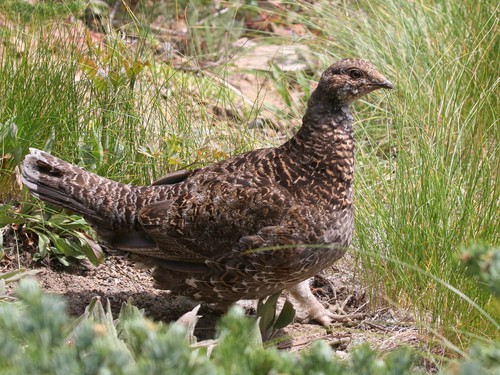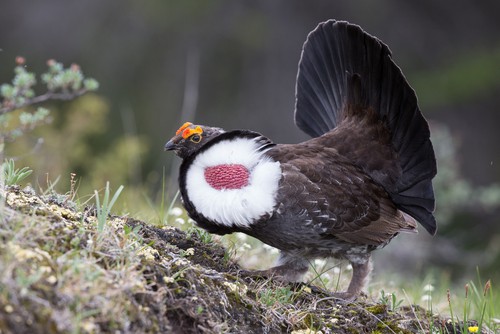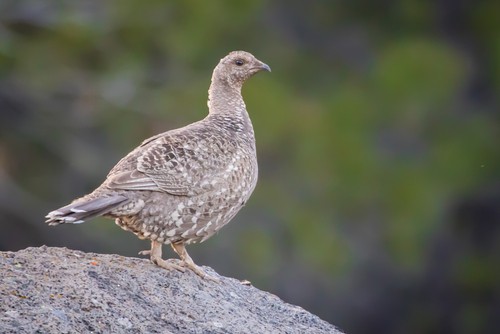Blue grouse are large mountain grouse that inhabit the Rocky Mountains, the Sierra Nevada, and the Pacific coastal range. They actually stem from two closely related but distinct species, the Sooty grouse and the Dusky Grouse. Up until the year 2006, they were collectively considered to be one species, the Blue grouse. DNA evidence proved that they are two separate species. However, when we refer to Dusky Grouse or Sooty Grouse, they are both the same thing as Blue Grouse.


Sooty Grouse (Dendragapus fuliginosus)
Sooty Grouse inhabit the Sierra Nevada and Pacific Coastal ranges.
Male and female Sooty grouse display some sexual dimorphism. Females are about 2/3 the size of males. Collectively their size ranges from around 15.8 to19.7 inches (40 to 50 centimeters) in body length and 1.66 to 2.87 pounds (750 to 1300 grams) in weight. Source Source These birds are stocky in their build. In fact, as they walk along the ground, they almost resemble a chicken. Both sexes have tails of medium length that they can fan into a semi-circle.
In coloration, both sexes have a camouflage pattern of alternating grey, white, brown, and black. The males of the species trend to a predominantly grey coloration while females are more brown. Males have dark grey tails with lighter sleight grey tips. Additionally, males have yellow air sacks in their throats and a yellow comb above each eye when they are on full mating display.
Sooty Grouse Range
Sooty grouse inhabit the Pacific Coastal ranges from southeastern Alaska in the north to southern California in the south. They also live inland in the Sierra Nevada mountains of California and Nevada.
Sooty Grouse Habitat
Coniferous to sub-alpine forests, consisting of fir, hemlock, and pine trees. Additionally, they prefer locations bordering clear-cut and burnt-off areas. They also are more prevalent in forested areas with extensive undergrowth of shrubs and grasses.
Sooty Grouse Diet
In the winter, they eat conifer, such as Douglas fir, spruce, Western, and Mountain hemlock tree needles. When spring and summer roll around, their diet shifts to eating leaves, buds, grass, and insects. In the fall, when they are ripe, berries make up a large portion of their diet.
Sooty Grouse Behavior
Sooty Grouse spend a good deal of time feeding on the forest floor. They are well camouflaged in their surroundings and depend on this fact for protection from predators. When you come upon one, they are at times surprisingly tame. This is a trait they share with their fellow blue grouse species, the Dusky Grouse. This gives cause to the unflattering “fool hen” nickname that Blue grouse have earned in some quarters.
In late March, Sooty Grouse males begin calling for receptive females. They do this from high up in an evergreen tree, and the sound carries for miles. As they call for females, the yellow air sack in the male’s throat and his yellow eye combs are on full display.
After successfully mating, females scratch a nest on the forest floor wherein they deposit 5 to 9 eggs. Incubation of eggs takes 24 to 26 days.


Dusky Grouse (Dendragapus obscurus)
Dusky Grouse are the second half of the duo that is collectively called Blue Grouse. These birds inhabit the Rocky Mountains.
Like Sooty grouse, these birds are also sexually dimorphic. Adult dusky grouse males are 18.5 to 22.5 inches ( 47 to 57cm) in length and weigh from 2 1/2 to 3 pounds (1.13 to 1.36 kg), while hens are 17 to 19 inches (43 to 48 cm) in length and weigh about 2 pounds (907 grams). Source
Dusky grouse are mottled grey in color. The male or cock is more grey, while the female or hen tends to be more grey-brown. Both of the sexes have medium-length square-shaped tails that they can fan out into a half-circle. The male’s tail is bluish grey to black. When they are in full mating display, dusky grouse males have purplish-red air sacks that protrude from each side of their throat. A border of white feathers surrounds these air sacks. In mating displays, males also have either yellow or red combs above each eye.
Dusky Grouse Range
Dusky Grouse live predominantly in the Rocky Mountain states and Canadian Provinces. The northern end of their range begins in the Yukon, the Northwest Territories, and Northern British Columbia. It extends through British Columbia and Alberta and across the United States border into Washington, Idaho, and Montana. Their range then extends down the Rocky Mountains as far as Northern New Mexico. In the United States, Washington, Oregon, Idaho, Montana, Wyoming, Colorado, Utah, Nevada, and New Mexico all have populations of Dusky Grouse.
Dusky Grouse Habitat
In the spring, they live in or near forests that may be made up predominantly of Quaking aspen, Ponderosa pine, or Douglas fir. They move out from these forested areas into the surrounding grass, sage, or buckbrush-covered steppes when they forage. As spring progresses into summer, they tend to move into higher elevation, sub-alpine habitat. In the winter, some dusky grouse populations stay in this high country environment feeding on evergreen needles through the season while others move back to lower elevations. Source
Dusky Grouse Diet
In the winter, their diet might consist almost entirely of evergreen needles and buds. In the spring, they switch over to eating the bud’s leaves from deciduous plants. Their spring and summertime diet also includes insects. Chicks have a higher percentage of insect protein in their diet than do mature birds. Dusky Grouse also feast on berries such as Oregon Grapes and Snowberries when they are ripe.
Dusky Grouse Mating Behavior
Mating season for dusky grouse begins in the early spring. Males chase all other males from their territory. Their territory, by the way, is generally 400 to 500 feet from top to bottom and side to side.
Males advertise to prospective mates by strutting with their tails fanned out, hooting and fluttering in circular patterns. When a female enters their territory, they up their game by exposing the inflatable purple sacks on the sides of their throats. The yellow or red combs above each eye also become engorged and stand erect. Males continue this courting behavior for several weeks each spring. Source
Females lay 7 to 16 eggs in nests that they scratch out on the forest floor, generally under the shelter of an overhanging object such as a stump or a shrub.
Dusky Grouse General Behavior
In this department, Dusky Grouse are very similar to Sooty Grouse. They do a lot of feeding along the ground and depend on their camouflage for protection from predators. When you come upon one of these birds, sometimes they’ll explode from cover and give a heart attack in the process. Other times they’ll walk along the ground and act shockingly tame. This gives rise to the “fool hen” nickname they share with sooty grouse.
Additionally, hens with young will feign injury to draw a predator’s attention away from her chicks. She won’t stop there, though. If the predator is still keyed in on her offspring, she’s willing to fly at and ram whatever animal is a danger to her chicks. Source
Final Thoughts
Blue Grouse live in some of the best places on earth, and the worst day pursuing them is far better than the best day at work. They also make excellent table fare. The Blue Grouse that I have eaten were much better than chicken. If you’ve never ventured after this excellent upland bird, make a resolution to do so.
You might also like Ring-Necked Pheasant – Krebs Creek
Facts About Ptarmigan – Krebs Creek
Chukar Partridge – Krebs Creek
Recent Posts
The only venomous snakes in Washington State are Northern Pacific Rattlesnakes. The Northern Pacific Rattlesnake (Crotalus oreganus oreganus) is a sub-species of the Western Rattlesnake. Anyone...
Skunks are not classified as true hibernators. But they go into a state of torpor when the weather gets cold. Skunks are light sleep hibernators, along with opossums, bears, and raccoons. ...

